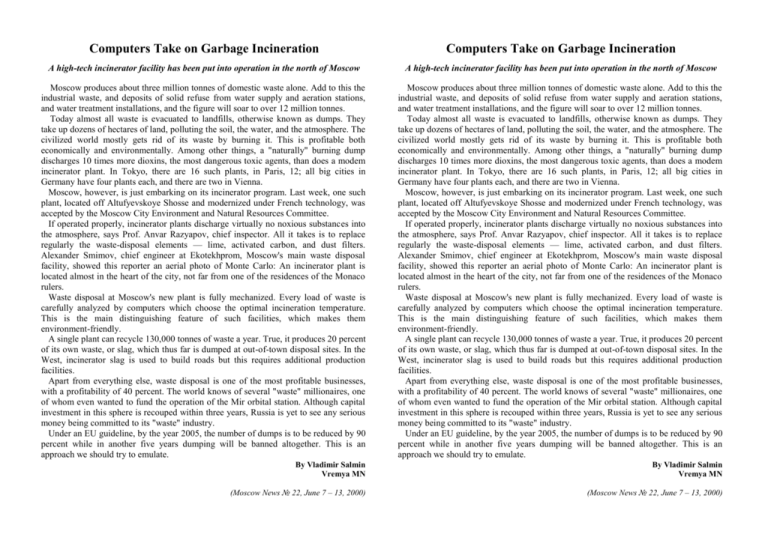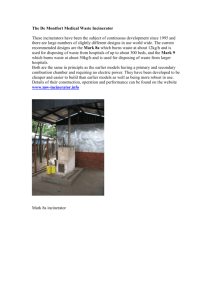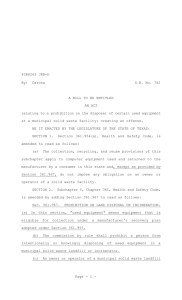Computers Take on Garbage Incineration
advertisement

Computers Take on Garbage Incineration Computers Take on Garbage Incineration A high-tech incinerator facility has been put into operation in the north of Moscow A high-tech incinerator facility has been put into operation in the north of Moscow Moscow produces about three million tonnes of domestic waste alone. Add to this the industrial waste, and deposits of solid refuse from water supply and aeration stations, and water treatment installations, and the figure will soar to over 12 million tonnes. Today almost all waste is evacuated to landfills, otherwise known as dumps. They take up dozens of hectares of land, polluting the soil, the water, and the atmosphere. The civilized world mostly gets rid of its waste by burning it. This is profitable both economically and environmentally. Among other things, a "naturally" burning dump discharges 10 times more dioxins, the most dangerous toxic agents, than does a modem incinerator plant. In Tokyo, there are 16 such plants, in Paris, 12; all big cities in Germany have four plants each, and there are two in Vienna. Moscow, however, is just embarking on its incinerator program. Last week, one such plant, located off Altufyevskoye Shosse and modernized under French technology, was accepted by the Moscow City Environment and Natural Resources Committee. If operated properly, incinerator plants discharge virtually no noxious substances into the atmosphere, says Prof. Anvar Razyapov, chief inspector. All it takes is to replace regularly the waste-disposal elements — lime, activated carbon, and dust filters. Alexander Smimov, chief engineer at Ekotekhprom, Moscow's main waste disposal facility, showed this reporter an aerial photo of Monte Carlo: An incinerator plant is located almost in the heart of the city, not far from one of the residences of the Monaco rulers. Waste disposal at Moscow's new plant is fully mechanized. Every load of waste is carefully analyzed by computers which choose the optimal incineration temperature. This is the main distinguishing feature of such facilities, which makes them environment-friendly. A single plant can recycle 130,000 tonnes of waste a year. True, it produces 20 percent of its own waste, or slag, which thus far is dumped at out-of-town disposal sites. In the West, incinerator slag is used to build roads but this requires additional production facilities. Apart from everything else, waste disposal is one of the most profitable businesses, with a profitability of 40 percent. The world knows of several "waste" millionaires, one of whom even wanted to fund the operation of the Mir orbital station. Although capital investment in this sphere is recouped within three years, Russia is yet to see any serious money being committed to its "waste" industry. Under an EU guideline, by the year 2005, the number of dumps is to be reduced by 90 percent while in another five years dumping will be banned altogether. This is an approach we should try to emulate. Moscow produces about three million tonnes of domestic waste alone. Add to this the industrial waste, and deposits of solid refuse from water supply and aeration stations, and water treatment installations, and the figure will soar to over 12 million tonnes. Today almost all waste is evacuated to landfills, otherwise known as dumps. They take up dozens of hectares of land, polluting the soil, the water, and the atmosphere. The civilized world mostly gets rid of its waste by burning it. This is profitable both economically and environmentally. Among other things, a "naturally" burning dump discharges 10 times more dioxins, the most dangerous toxic agents, than does a modem incinerator plant. In Tokyo, there are 16 such plants, in Paris, 12; all big cities in Germany have four plants each, and there are two in Vienna. Moscow, however, is just embarking on its incinerator program. Last week, one such plant, located off Altufyevskoye Shosse and modernized under French technology, was accepted by the Moscow City Environment and Natural Resources Committee. If operated properly, incinerator plants discharge virtually no noxious substances into the atmosphere, says Prof. Anvar Razyapov, chief inspector. All it takes is to replace regularly the waste-disposal elements — lime, activated carbon, and dust filters. Alexander Smimov, chief engineer at Ekotekhprom, Moscow's main waste disposal facility, showed this reporter an aerial photo of Monte Carlo: An incinerator plant is located almost in the heart of the city, not far from one of the residences of the Monaco rulers. Waste disposal at Moscow's new plant is fully mechanized. Every load of waste is carefully analyzed by computers which choose the optimal incineration temperature. This is the main distinguishing feature of such facilities, which makes them environment-friendly. A single plant can recycle 130,000 tonnes of waste a year. True, it produces 20 percent of its own waste, or slag, which thus far is dumped at out-of-town disposal sites. In the West, incinerator slag is used to build roads but this requires additional production facilities. Apart from everything else, waste disposal is one of the most profitable businesses, with a profitability of 40 percent. The world knows of several "waste" millionaires, one of whom even wanted to fund the operation of the Mir orbital station. Although capital investment in this sphere is recouped within three years, Russia is yet to see any serious money being committed to its "waste" industry. Under an EU guideline, by the year 2005, the number of dumps is to be reduced by 90 percent while in another five years dumping will be banned altogether. This is an approach we should try to emulate. By Vladimir Salmin Vremya MN By Vladimir Salmin Vremya MN (Moscow News № 22, June 7 – 13, 2000) (Moscow News № 22, June 7 – 13, 2000)






